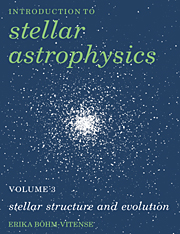Book contents
- Frontmatter
- Contents
- Preface
- 1 Introduction
- 2 Hydrostatic equilibrium
- 3 Thermal equilibrium
- 4 The opacities
- 5 Convective instability
- 6 Theory of convective energy transport
- 7 Depths of the outer convection zones
- 8 Energy generation in stars
- 9 Basic stellar structure equations
- 10 Homologous stars in radiative equilibrium
- 11 Influence of convection zones on stellar structure
- 12 Calculation of stellar models
- 13 Models for main sequence stars
- 14 Evolution of low mass stars
- 15 Evolution of massive stars
- 16 Late stages of stellar evolution
- 17 Observational tests of stellar evolution theory
- 18 Pulsating stars
- 19 The Cepheid mass problem
- 20 Star formation
- Appendix Radiative energy transport in stars
- Problems
- References
- Index
17 - Observational tests of stellar evolution theory
Published online by Cambridge University Press: 08 January 2010
- Frontmatter
- Contents
- Preface
- 1 Introduction
- 2 Hydrostatic equilibrium
- 3 Thermal equilibrium
- 4 The opacities
- 5 Convective instability
- 6 Theory of convective energy transport
- 7 Depths of the outer convection zones
- 8 Energy generation in stars
- 9 Basic stellar structure equations
- 10 Homologous stars in radiative equilibrium
- 11 Influence of convection zones on stellar structure
- 12 Calculation of stellar models
- 13 Models for main sequence stars
- 14 Evolution of low mass stars
- 15 Evolution of massive stars
- 16 Late stages of stellar evolution
- 17 Observational tests of stellar evolution theory
- 18 Pulsating stars
- 19 The Cepheid mass problem
- 20 Star formation
- Appendix Radiative energy transport in stars
- Problems
- References
- Index
Summary
Color magnitude diagrams for globular clusters
The best way to check stellar evolution calculations is, of course, to compare calculated and observed evolutionary tracks. Unfortunately we cannot follow the evolution of one star through its lifetime, because our lifetime is too short – not even the lifetime of scientifically interested humanity is long enough. Only in rare cases may we observe changes in the appearance of one star, for instance when it becomes a supernova. Another example occurred some decades ago when FG Sagittae suddenly became far bluer, a rare example of stellar changes which are too fast to fit into our present understanding of stellar evolution.
Generally evolutionary changes of stars are expected to take place over times of at least 104 years (except perhaps for stars on the Hayashi track, where massive stars may evolve somewhat faster). How then can we compare evolutionary tracks? Fortunately there are star clusters which contain up to 105 stars all of which are nearly the same age but of different masses. In such very populous clusters there are a large number of stars which have nearly the same masses.
In Fig. 17.1 we show schematically evolutionary tracks of stars with about one solar mass. They all originate near spectral types G0 or G2 on the main sequence. Their lifetime, t, on the main sequence is about 1010 years. The evolution to the red giant branch takes about 107 years.
- Type
- Chapter
- Information
- Introduction to Stellar Astrophysics , pp. 213 - 221Publisher: Cambridge University PressPrint publication year: 1992

